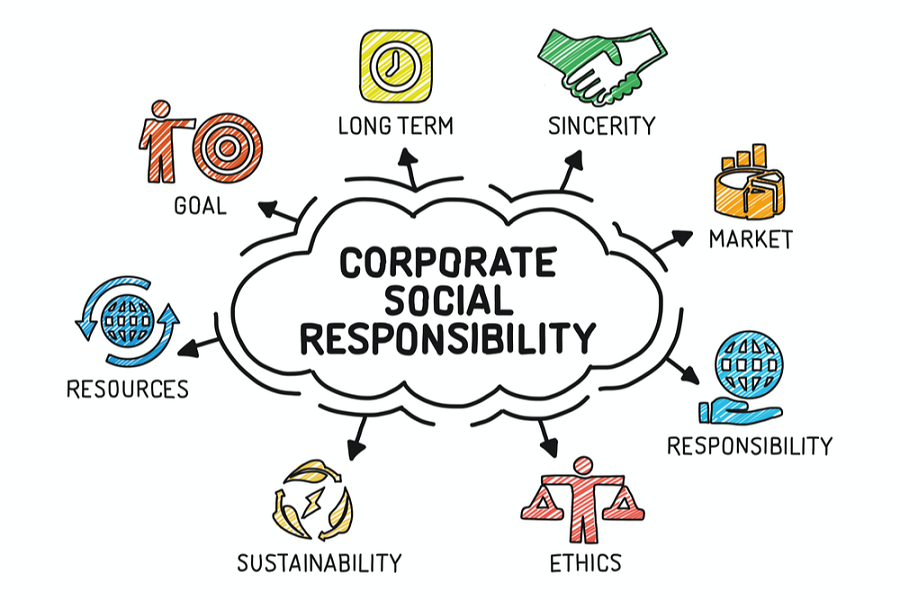5 Ways To Promote Corporate Social Responsibility on Social Media

In a world where corporate social responsibility is becoming increasingly important, it’s essential for businesses to understand how to create engaging content that promotes such values. According to a digital marketing agency, content that is created with CSR in mind can help to differentiate a business from its competitors, as well as create a positive reputation for the company.
In this blog post, we’ll provide five steps for creating content to promote corporate social responsibility.
We’ll cover understanding your audience, identifying the message you want to convey, establishing your goals, utilizing different content types, and utilizing social media platforms. By following these steps, businesses will be able to create powerful and engaging content to promote their corporate social responsibility values.
1. Understand Your Audience
——————————–
Creating content to promote corporate social responsibility (CSR) can be a great way to engage audiences and spread your message. However, in order to create content that resonates with your target audience, a digital marketing agency suggests that it is important to first understand who your audience is and what they’re looking for.
First, consider the demographics of your target audience. Who are you trying to reach through your content? Is your content meant for a general audience or a specific group of people? Knowing the age, gender, and interests of your audience will help you tailor your content to be more relevant to them.
Next, think about the values of your target audience. Do they prioritize environmental sustainability? Are they passionate about supporting local businesses and communities? Understanding the values of your audience can help you create content that speaks to their interests and resonates with them emotionally.
You should also consider the type of content your audience is already consuming. Are they engaging with content related to CSR on social media? What websites do they visit? By understanding the type of content your audience is already engaging with, you can create content that is similar in format and style.
Finally, consider the platforms your audience is most active on. Where are they spending the most time? If your audience primarily uses Instagram, you may want to focus on creating content specifically for that platform.
By understanding your audience, you can create content that speaks to their values and interests and is tailored to the platform they’re most active on. This can help ensure that your content is engaging and resonates with your target audience.
2. Identify the Message You Want to Convey
——————————–
When promoting corporate social responsibility (CSR) through content, it is important to identify the message you want to convey to ensure your audience understands your purpose. When creating content, you should ask yourself what the key message you want to get across is. Consider what will make your audience act and what will be the most effective way to spread the message.
When creating content about CSR, it is important to stay mindful of your audience. Make sure you are creating content that matches their interests and needs. It is important to identify who your audience is and why they should care about your CSR message. Ask yourself what type of content resonates the most with your target audience.
Once you have identified your target audience and the message you want to convey, you can start to establish goals. Think about what you want to achieve with your CSR content and how you can track the results. Consider how many people you want to reach, how you want to engage them, and what type of impact you want to make with your CSR content.
When creating content to promote CSR, it is important to utilize different content types. This could include videos, blog posts, infographics, podcasts, and more. Consider which content types best suit your audience and message.
Additionally, a top digital marketing services agency suggests thinking about the different platforms you can use to reach your audience. Utilize social media platforms, such as Twitter, Facebook, Instagram, and LinkedIn, to reach your target audience and share your CSR message.
By understanding your target audience, identifying the message you want to convey, setting goals, and utilizing different content types and social media platforms, you can create engaging content to promote corporate social responsibility.
3. Establish Your Goals
——————————–
Establishing goals for your corporate social responsibility content is essential for creating an effective campaign. Your goals should be tailored to fit your company’s mission and values. For example, if your company’s goal is to reduce its environmental impact, you can establish a goal of increasing public awareness of your company’s commitment to sustainability.
You can also set quantitative goals, such as increasing the number of people who follow your company’s social media accounts or the number of people who take part in your sustainability initiatives.
Your goals should also be realistic and achievable. Consider what resources you have available, such as budget, staff, and time, and set goals that can be met within those constraints. Additionally, your goals should be measurable so that you can track your progress and adjust your strategy if needed.
 It’s also important to consider how you will evaluate the success of your corporate social responsibility campaign. A good way to do this is to create a KPI (key performance indicator) report, which will provide you with an overview of the performance of your content.
It’s also important to consider how you will evaluate the success of your corporate social responsibility campaign. A good way to do this is to create a KPI (key performance indicator) report, which will provide you with an overview of the performance of your content.
This report should include metrics such as reach, engagement, and conversions, as well as the amount of time it took to achieve your goals. By establishing measurable goals and regularly monitoring your performance, you can ensure that your corporate social responsibility campaign is successful.
4. Utilize Different Content Types
——————————–
Utilizing different content types is essential for promoting corporate social responsibility. Different types of content can be used to reach different audiences, giving you the opportunity to tailor your message to the people you are trying to reach. There are several different types of content you can use to promote corporate social responsibility.
Video is a great way to get your message across in an engaging and memorable way. Videos can be used to tell stories, show how a company is taking action, or educate viewers on important topics. Videos can also be shared across various social media platforms, making them an effective way to reach a wide audience.
Infographics are another great way to promote corporate social responsibility. Infographics are visual representations of data or information, making them easy to understand and share with others. They can also be used to explain complex topics in a simple way and can be shared across multiple platforms.
Websites are a great way to provide more detailed information about a company’s corporate social responsibility efforts. Websites can be used to give detailed information about a company’s initiatives, provide resources for those interested in learning more about corporate social responsibility, and provide a platform for people to get involved in a company’s efforts.
Social media is one of the most effective ways to promote corporate social responsibility. Social media platforms can be used to share stories, promote campaigns, and engage with followers. Social media also allows companies to share updates on their progress and successes, giving people an inside look at the company’s efforts.
By utilizing different content types, companies can effectively promote corporate social responsibility and reach a wide audience. Different content types can be used to tell stories, educate viewers, and engage with followers, making them an essential part of any corporate social responsibility campaign.
5. Utilize Social Media Platforms
——————————–
Social media platforms are a great way to promote corporate social responsibility (CSR). By utilizing these platforms, you can reach a wider audience and engage them in an interactive way. You can post content such as videos, photos, and text that can be shared and liked by others, creating a ripple effect of awareness.
When using social media platforms, it is important to use them strategically. You should create content that is relevant to your CSR message and target the right audience. To do this, you can use analytics tools to find out which platforms are most popular with your target demographic. Knowing this, you can tailor your content to be more effective and engaging.
In addition, you should create a social media strategy that outlines how you plan to use each platform. This should include when you post, the type of content you will post, and the frequency of posts. You should also have a plan in place for responding to comments and engaging with followers.
Finally, you should track the performance of your social media campaigns to ensure that you are reaching your goals. This can be done by monitoring the number of likes, shares, and comments you receive on each post. You can also measure the success of your campaigns by comparing the number of followers before and after each campaign.
By utilizing social media platforms, you can create engaging content to promote corporate social responsibility in an effective and efficient way. With the right strategy and digital marketing agency experts’ analytics in place, you can reach a wider audience and create a ripple effect of awareness.
Conclusion
In conclusion, creating engaging content to promote corporate social responsibility is essential for any business. By understanding your audience, identifying the message you want to convey, establishing your goals, utilizing different content types, and leveraging various social media platforms, you will be able to create effective content that will reach and engage your target audience. Doing so successfully will help to build a positive reputation, attract more customers, and ultimately, create a greater impact on corporate social responsibility.




